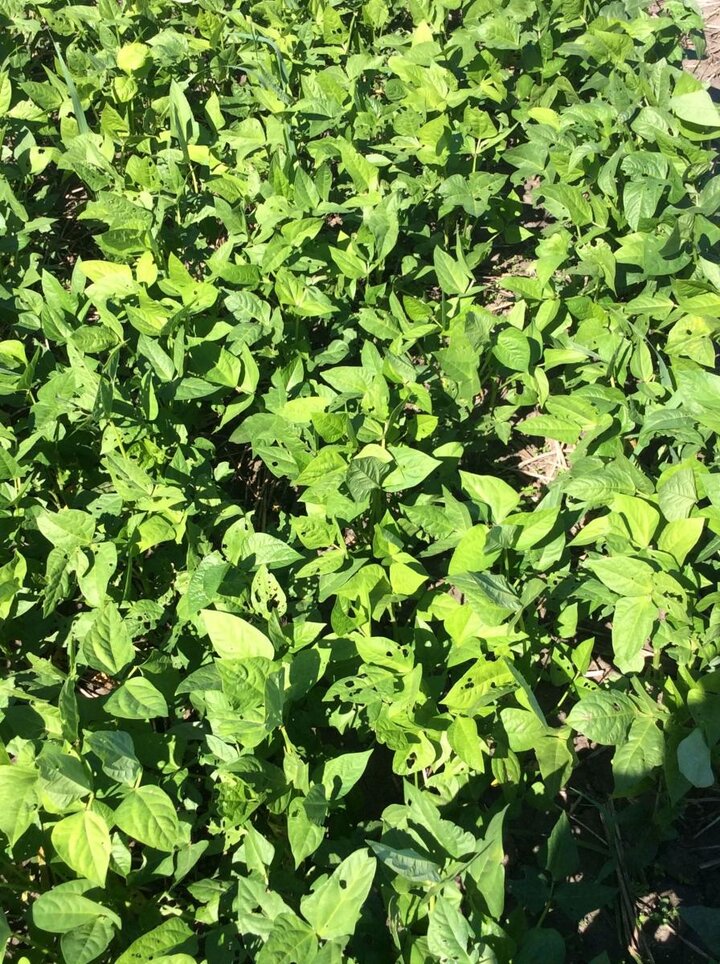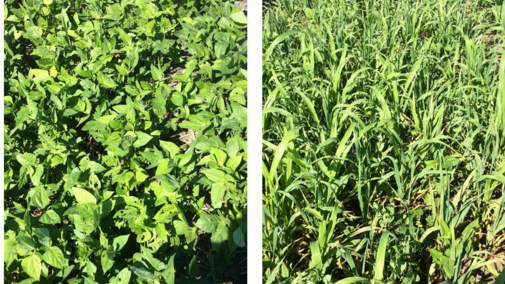One expected benefit of using legumes as a cover crop is to provide a source of nitrogen (N) to the cropping system. However, when legumes are included in mixtures with grasses and broadleaves for a relatively short growing period, the amount of actual fixed N may be relatively low. Even when planted as a monoculture or legume-only mixture, the amount of fixed N may be lower than anticipated.


Figure 1. Legumes vary in the amount of biomass and nitrogen they provide. Shown above are two legume-based cover crops: Cowpea (left) and a grass mix (right) with cowpea as one of its components.
The N fixation process is a chemical reaction facilitated by Rhizobia bacteria in root nodules that convert atmospheric N (N2) to ammonia (NH3). This process uses energy produced by the legume plant during photosynthesis. The ammonia is almost immediately converted to ammonium (NH4). Using the N in ammonium and the carbohydrates from photosynthesis as energy, plant proteins are formed and become part of legume plants. It is important to note it can take up to six weeks after planting before N fixation begins.
Many factors determine the amount of nitrogen (N) that can be fixed by different legumes used as cover crops or forage cover crops:
- Different legumes fix different amounts of N.
- Legumes must form effective root nodules to fix N.
- Legumes often use available soil N for growth before beginning to fix N.
- Well-established legumes fix more N than do seedling legumes.
- Legumes do not have equal biomass yield potential.
Together, this means that different legumes and different legume growth environments provide greatly different amounts of fixed N.
Little information is available on the amount of N that is fixed when legumes are grown as cover crops. Much information has been generalized from forage and pasture studies of mixed stands of grasses and legumes. In mixed perennial grass-legume pastures, reported values for suitable legume stands of clovers and vetches often range from 50 to 100 pounds fixed N per acre for annual N fixation of legumes in mixed pastures.
Most reported fixed N rates are for a full year of growth from full stands of monoculture legumes. Well-established perennial legumes, including red and white clover, have been reported to provide 75 to 200 pounds fixed N per acre. This compares with alfalfa, which provides 150 to 200 pounds fixed N per acre.
Legumes behave much like grasses when soil N is available and will use that before fixing additional N. This means that legumes can scavenge N from the soil just as grasses do. That N can be released back to the soil later for use by succeeding crops as the legume biomass decomposes. The amount released will depend primarily on the concentration of N in the legume biomass and the amount of biomass produced.
On average, summer annual legumes, including cowpea, mungbean, soybean, and sunn hemp, typically have the lowest N concentrations of the legumes. When mature, these are often around 2% N (12% to 14% crude protein). Winter annual legumes, such as crimson clover and the vetches are often around 3% N (18% to 20% crude protein). Some perennial pasture legumes such as red clover, white clover, and alfalfa can have up to 4% N (25% crude protein).
Other factors can further reduce the amount of N provided by legumes:
- Poor growing conditions can reduce legume biomass yield and fixed N contribution.
- In some cover crop mixtures, legumes are not major contributors to overall biomass production.
For example, Austrian winter pea and cowpea are two legumes commonly used as cover crops or included in cover crop mixtures. In pure stands with poor growing conditions, biomass yields are often less than 1500 pounds per acre. With a concentration of 2% N, less than 30 pounds N per acre would be fixed. Typically, biomass yields from legumes in excess of 1500 pounds per acre are required to provide appreciable amounts of fixed or scavenged N.
As long as legume cover crops are not harvested, nearly all the fixed and scavenged N eventually becomes available to subsequent crops. Very little N remains in the soil while plants are actively growing. This N is available for uptake by both legumes and other non-legume species.

